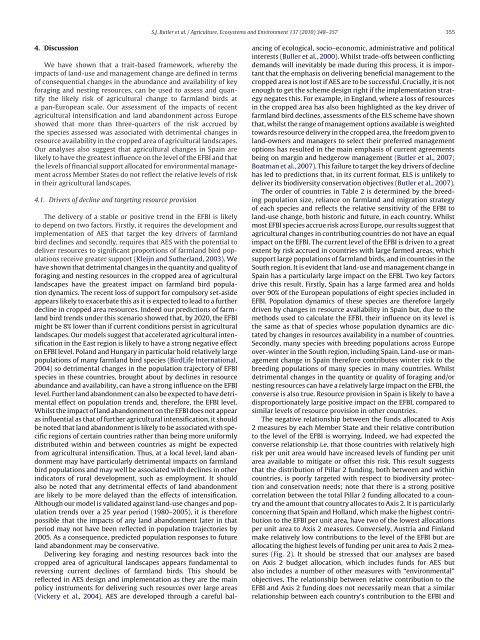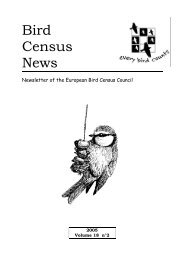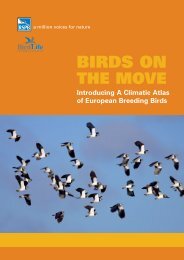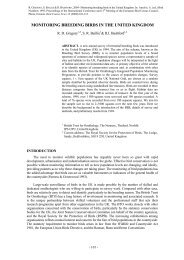Quantifying the impact of land-use change to European farmland ...
Quantifying the impact of land-use change to European farmland ...
Quantifying the impact of land-use change to European farmland ...
You also want an ePaper? Increase the reach of your titles
YUMPU automatically turns print PDFs into web optimized ePapers that Google loves.
4. Discussion<br />
We have shown that a trait-based framework, whereby <strong>the</strong><br />
<strong>impact</strong>s <strong>of</strong> <strong>land</strong>-<strong>use</strong> and management <strong>change</strong> are defined in terms<br />
<strong>of</strong> consequential <strong>change</strong>s in <strong>the</strong> abundance and availability <strong>of</strong> key<br />
foraging and nesting resources, can be <strong>use</strong>d <strong>to</strong> assess and quantify<br />
<strong>the</strong> likely risk <strong>of</strong> agricultural <strong>change</strong> <strong>to</strong> farm<strong>land</strong> birds at<br />
a pan-<strong>European</strong> scale. Our assessment <strong>of</strong> <strong>the</strong> <strong>impact</strong>s <strong>of</strong> recent<br />
agricultural intensification and <strong>land</strong> abandonment across Europe<br />
showed that more than three-quarters <strong>of</strong> <strong>the</strong> risk accrued by<br />
<strong>the</strong> species assessed was associated with detrimental <strong>change</strong>s in<br />
resource availability in <strong>the</strong> cropped area <strong>of</strong> agricultural <strong>land</strong>scapes.<br />
Our analyses also suggest that agricultural <strong>change</strong>s in Spain are<br />
likely <strong>to</strong> have <strong>the</strong> greatest influence on <strong>the</strong> level <strong>of</strong> <strong>the</strong> EFBI and that<br />
<strong>the</strong> levels <strong>of</strong> financial support allocated for environmental management<br />
across Member States do not reflect <strong>the</strong> relative levels <strong>of</strong> risk<br />
in <strong>the</strong>ir agricultural <strong>land</strong>scapes.<br />
4.1. Drivers <strong>of</strong> decline and targeting resource provision<br />
The delivery <strong>of</strong> a stable or positive trend in <strong>the</strong> EFBI is likely<br />
<strong>to</strong> depend on two fac<strong>to</strong>rs. Firstly, it requires <strong>the</strong> development and<br />
implementation <strong>of</strong> AES that target <strong>the</strong> key drivers <strong>of</strong> farm<strong>land</strong><br />
bird declines and secondly, requires that AES with <strong>the</strong> potential <strong>to</strong><br />
deliver resources <strong>to</strong> significant proportions <strong>of</strong> farm<strong>land</strong> bird populations<br />
receive greater support (Kleijn and Su<strong>the</strong>r<strong>land</strong>, 2003). We<br />
have shown that detrimental <strong>change</strong>s in <strong>the</strong> quantity and quality <strong>of</strong><br />
foraging and nesting resources in <strong>the</strong> cropped area <strong>of</strong> agricultural<br />
<strong>land</strong>scapes have <strong>the</strong> greatest <strong>impact</strong> on farm<strong>land</strong> bird population<br />
dynamics. The recent loss <strong>of</strong> support for compulsory set-aside<br />
appears likely <strong>to</strong> exacerbate this as it is expected <strong>to</strong> lead <strong>to</strong> a fur<strong>the</strong>r<br />
decline in cropped area resources. Indeed our predictions <strong>of</strong> farm<strong>land</strong><br />
bird trends under this scenario showed that, by 2020, <strong>the</strong> EFBI<br />
might be 8% lower than if current conditions persist in agricultural<br />
<strong>land</strong>scapes. Our models suggest that accelerated agricultural intensification<br />
in <strong>the</strong> East region is likely <strong>to</strong> have a strong negative effect<br />
on EFBI level. Po<strong>land</strong> and Hungary in particular hold relatively large<br />
populations <strong>of</strong> many farm<strong>land</strong> bird species (BirdLife International,<br />
2004) so detrimental <strong>change</strong>s in <strong>the</strong> population trajec<strong>to</strong>ry <strong>of</strong> EFBI<br />
species in <strong>the</strong>se countries, brought about by declines in resource<br />
abundance and availability, can have a strong influence on <strong>the</strong> EFBI<br />
level. Fur<strong>the</strong>r <strong>land</strong> abandonment can also be expected <strong>to</strong> have detrimental<br />
effect on population trends and, <strong>the</strong>refore, <strong>the</strong> EFBI level.<br />
Whilst <strong>the</strong> <strong>impact</strong> <strong>of</strong> <strong>land</strong> abandonment on <strong>the</strong> EFBI does not appear<br />
as influential as that <strong>of</strong> fur<strong>the</strong>r agricultural intensification, it should<br />
be noted that <strong>land</strong> abandonment is likely <strong>to</strong> be associated with specific<br />
regions <strong>of</strong> certain countries ra<strong>the</strong>r than being more uniformly<br />
distributed within and between countries as might be expected<br />
from agricultural intensification. Thus, at a local level, <strong>land</strong> abandonment<br />
may have particularly detrimental <strong>impact</strong>s on farm<strong>land</strong><br />
bird populations and may well be associated with declines in o<strong>the</strong>r<br />
indica<strong>to</strong>rs <strong>of</strong> rural development, such as employment. It should<br />
also be noted that any detrimental effects <strong>of</strong> <strong>land</strong> abandonment<br />
are likely <strong>to</strong> be more delayed than <strong>the</strong> effects <strong>of</strong> intensification.<br />
Although our model is validated against <strong>land</strong>-<strong>use</strong> <strong>change</strong>s and population<br />
trends over a 25 year period (1980–2005), it is <strong>the</strong>refore<br />
possible that <strong>the</strong> <strong>impact</strong>s <strong>of</strong> any <strong>land</strong> abandonment later in that<br />
period may not have been reflected in population trajec<strong>to</strong>ries by<br />
2005. As a consequence, predicted population responses <strong>to</strong> future<br />
<strong>land</strong> abandonment may be conservative.<br />
Delivering key foraging and nesting resources back in<strong>to</strong> <strong>the</strong><br />
cropped area <strong>of</strong> agricultural <strong>land</strong>scapes appears fundamental <strong>to</strong><br />
reversing current declines <strong>of</strong> farm<strong>land</strong> birds. This should be<br />
reflected in AES design and implementation as <strong>the</strong>y are <strong>the</strong> main<br />
policy instruments for delivering such resources over large areas<br />
(Vickery et al., 2004). AES are developed through a careful bal-<br />
S.J. Butler et al. / Agriculture, Ecosystems and Environment 137 (2010) 348–357 355<br />
ancing <strong>of</strong> ecological, socio–economic, administrative and political<br />
interests (Buller et al., 2000). Whilst trade-<strong>of</strong>fs between conflicting<br />
demands will inevitably be made during this process, it is important<br />
that <strong>the</strong> emphasis on delivering beneficial management <strong>to</strong> <strong>the</strong><br />
cropped area is not lost if AES are <strong>to</strong> be successful. Crucially, it is not<br />
enough <strong>to</strong> get <strong>the</strong> scheme design right if <strong>the</strong> implementation strategy<br />
negates this. For example, in Eng<strong>land</strong>, where a loss <strong>of</strong> resources<br />
in <strong>the</strong> cropped area has also been highlighted as <strong>the</strong> key driver <strong>of</strong><br />
farm<strong>land</strong> bird declines, assessments <strong>of</strong> <strong>the</strong> ELS scheme have shown<br />
that, whilst <strong>the</strong> range <strong>of</strong> management options available is weighted<br />
<strong>to</strong>wards resource delivery in <strong>the</strong> cropped area, <strong>the</strong> freedom given <strong>to</strong><br />
<strong>land</strong>-owners and managers <strong>to</strong> select <strong>the</strong>ir preferred management<br />
options has resulted in <strong>the</strong> main emphasis <strong>of</strong> current agreements<br />
being on margin and hedgerow management (Butler et al., 2007;<br />
Boatman et al., 2007). This failure <strong>to</strong> target <strong>the</strong> key drivers <strong>of</strong> decline<br />
has led <strong>to</strong> predictions that, in its current format, ELS is unlikely <strong>to</strong><br />
deliver its biodiversity conservation objectives (Butler et al., 2007).<br />
The order <strong>of</strong> countries in Table 2 is determined by <strong>the</strong> breeding<br />
population size, reliance on farm<strong>land</strong> and migration strategy<br />
<strong>of</strong> each species and reflects <strong>the</strong> relative sensitivity <strong>of</strong> <strong>the</strong> EFBI <strong>to</strong><br />
<strong>land</strong>-<strong>use</strong> <strong>change</strong>, both his<strong>to</strong>ric and future, in each country. Whilst<br />
most EFBI species accrue risk across Europe, our results suggest that<br />
agricultural <strong>change</strong>s in contributing countries do not have an equal<br />
<strong>impact</strong> on <strong>the</strong> EFBI. The current level <strong>of</strong> <strong>the</strong> EFBI is driven <strong>to</strong> a great<br />
extent by risk accrued in countries with large farmed areas, which<br />
support large populations <strong>of</strong> farm<strong>land</strong> birds, and in countries in <strong>the</strong><br />
South region. It is evident that <strong>land</strong>-<strong>use</strong> and management <strong>change</strong> in<br />
Spain has a particularly large <strong>impact</strong> on <strong>the</strong> EFBI. Two key fac<strong>to</strong>rs<br />
drive this result. Firstly, Spain has a large farmed area and holds<br />
over 90% <strong>of</strong> <strong>the</strong> <strong>European</strong> populations <strong>of</strong> eight species included in<br />
EFBI. Population dynamics <strong>of</strong> <strong>the</strong>se species are <strong>the</strong>refore largely<br />
driven by <strong>change</strong>s in resource availability in Spain but, due <strong>to</strong> <strong>the</strong><br />
methods <strong>use</strong>d <strong>to</strong> calculate <strong>the</strong> EFBI, <strong>the</strong>ir influence on its level is<br />
<strong>the</strong> same as that <strong>of</strong> species whose population dynamics are dictated<br />
by <strong>change</strong>s in resources availability in a number <strong>of</strong> countries.<br />
Secondly, many species with breeding populations across Europe<br />
over-winter in <strong>the</strong> South region, including Spain. Land-<strong>use</strong> or management<br />
<strong>change</strong> in Spain <strong>the</strong>refore contributes winter risk <strong>to</strong> <strong>the</strong><br />
breeding populations <strong>of</strong> many species in many countries. Whilst<br />
detrimental <strong>change</strong>s in <strong>the</strong> quantity or quality <strong>of</strong> foraging and/or<br />
nesting resources can have a relatively large <strong>impact</strong> on <strong>the</strong> EFBI, <strong>the</strong><br />
converse is also true. Resource provision in Spain is likely <strong>to</strong> have a<br />
disproportionately large positive <strong>impact</strong> on <strong>the</strong> EFBI, compared <strong>to</strong><br />
similar levels <strong>of</strong> resource provision in o<strong>the</strong>r countries.<br />
The negative relationship between <strong>the</strong> funds allocated <strong>to</strong> Axis<br />
2 measures by each Member State and <strong>the</strong>ir relative contribution<br />
<strong>to</strong> <strong>the</strong> level <strong>of</strong> <strong>the</strong> EFBI is worrying. Indeed, we had expected <strong>the</strong><br />
converse relationship i.e. that those countries with relatively high<br />
risk per unit area would have increased levels <strong>of</strong> funding per unit<br />
area available <strong>to</strong> mitigate or <strong>of</strong>fset this risk. This result suggests<br />
that <strong>the</strong> distribution <strong>of</strong> Pillar 2 funding, both between and within<br />
countries, is poorly targeted with respect <strong>to</strong> biodiversity protection<br />
and conservation needs; note that <strong>the</strong>re is a strong positive<br />
correlation between <strong>the</strong> <strong>to</strong>tal Pillar 2 funding allocated <strong>to</strong> a country<br />
and <strong>the</strong> amount that country allocates <strong>to</strong> Axis 2. It is particularly<br />
concerning that Spain and Hol<strong>land</strong>, which make <strong>the</strong> highest contribution<br />
<strong>to</strong> <strong>the</strong> EFBI per unit area, have two <strong>of</strong> <strong>the</strong> lowest allocations<br />
per unit area <strong>to</strong> Axis 2 measures. Conversely, Austria and Fin<strong>land</strong><br />
make relatively low contributions <strong>to</strong> <strong>the</strong> level <strong>of</strong> <strong>the</strong> EFBI but are<br />
allocating <strong>the</strong> highest levels <strong>of</strong> funding per unit area <strong>to</strong> Axis 2 measures<br />
(Fig. 2). It should be stressed that our analyses are based<br />
on Axis 2 budget allocation, which includes funds for AES but<br />
also includes a number <strong>of</strong> o<strong>the</strong>r measures with “environmental”<br />
objectives. The relationship between relative contribution <strong>to</strong> <strong>the</strong><br />
EFBI and Axis 2 funding does not necessarily mean that a similar<br />
relationship between each country’s contribution <strong>to</strong> <strong>the</strong> EFBI and






